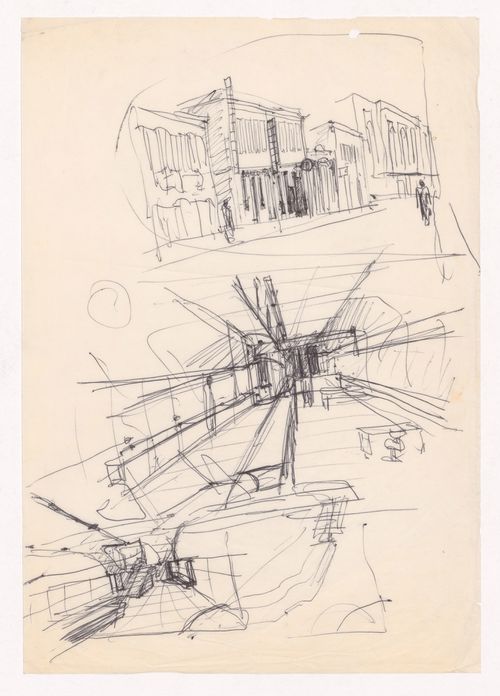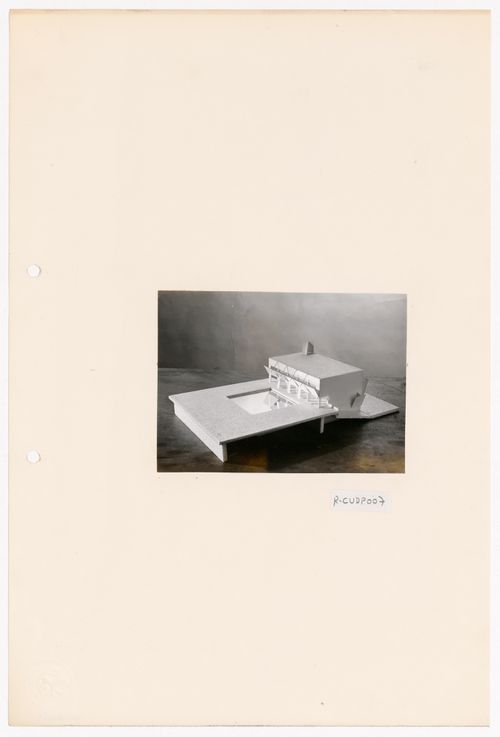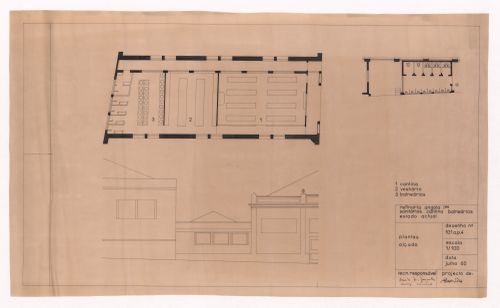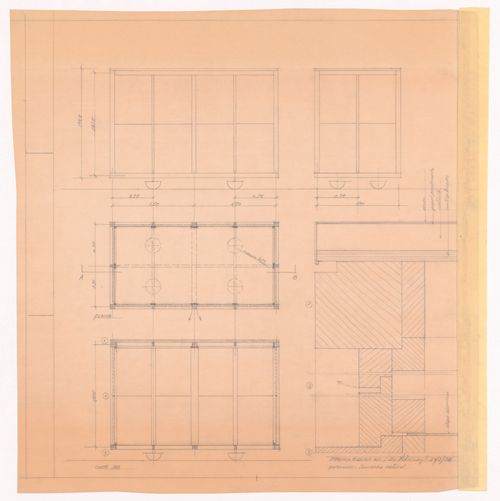ARCH290467
circa 1972-1974
Projet
AP178.S1.1983.PR03
Description:
This project series documents the Casa Mário Bahia in Gondomar, Portugal. While the records were held in the office’s archives this project was assigned the number 17/80. The office assigned the date 1983 to this project. The project files document a house comissionned by Mário Bahia. The 340 square metre home was supposed to be built on the slope of the river Douro. The design included five bedrooms and four bathrooms. An elevator and stairway were proposed to link the garage to the house. The house was not built. Documenting this project are sketches, studies, working drawings, structural drawings and technical drawings. Textual materials include project documentation and correspondence. Photographic materials document the model.
1983-1993
Casa Mário Bahia [Mário Bahia house], Gondomar, Portugal, 1983-1993
Actions:
AP178.S1.1983.PR03
Description:
This project series documents the Casa Mário Bahia in Gondomar, Portugal. While the records were held in the office’s archives this project was assigned the number 17/80. The office assigned the date 1983 to this project. The project files document a house comissionned by Mário Bahia. The 340 square metre home was supposed to be built on the slope of the river Douro. The design included five bedrooms and four bathrooms. An elevator and stairway were proposed to link the garage to the house. The house was not built. Documenting this project are sketches, studies, working drawings, structural drawings and technical drawings. Textual materials include project documentation and correspondence. Photographic materials document the model.
Project
1983-1993
Projet
AP178.S1.1998.PR09
Description:
This project series documents the Câmara Municipal de Penafiel in Penafiel, Portugal. While the records were held in the office’s archives this project was assigned the number 104/90. The office assigned the date 1998 for this project. The project site was located on 21,643 square metres of land, between Avenida Guedes and Rua Abilio Miranda. The building program included two distinct buildings. The first was a U-shaped building for the Town Hall with a three-storey underground parking lot. The second was a two-storey rectangular building with a five-storey tower and a courtyard, for the administrative department, finance department, urban planning department and environement department. The project was not realized. Documenting this project are sketches, studies, plans, and working drawings. Textual material includes project documentation, competition documentation, and correspondence. Photographic materials document the project site.
1998-2003
Câmara Municipal de Penafiel [Penafiel Town Hall], Penafiel, Portugal (1998)
Actions:
AP178.S1.1998.PR09
Description:
This project series documents the Câmara Municipal de Penafiel in Penafiel, Portugal. While the records were held in the office’s archives this project was assigned the number 104/90. The office assigned the date 1998 for this project. The project site was located on 21,643 square metres of land, between Avenida Guedes and Rua Abilio Miranda. The building program included two distinct buildings. The first was a U-shaped building for the Town Hall with a three-storey underground parking lot. The second was a two-storey rectangular building with a five-storey tower and a courtyard, for the administrative department, finance department, urban planning department and environement department. The project was not realized. Documenting this project are sketches, studies, plans, and working drawings. Textual material includes project documentation, competition documentation, and correspondence. Photographic materials document the project site.
Project
1998-2003
Projet
AP178.S1.1967.PR04
Description:
This project series documents the Casa Manuel Magalhães in Porto, Portugal. While the records were held in the office’s archives this project was assigned the number 29/60; in the past the office identified the project as number 119. The office assigned the dates 1967-1971 for this project. The project consisted of a concrete house located on Avenida dos Combatentes in Porto. There was no direct opening to the street and the building was surrounded by a cement wall. Client Manuel Magalhães commissioned the house as a rental home, but became personally involved during the construction and decided to move in with his family. In 2001, Siza designed an intercom for the house. Documenting this project are sketches, studies, plans, elevations, and details. Photographs, negatives, and slides document the site and building work. Textual documentation includes correspondence with the city of Porto, Manuel Magalhães and Fernando Teixeira Rodrigues.
1967-2001
Casa Manuel Magalhães [Manuel Magalhães house], Porto, Portugal (1967-1971)
Actions:
AP178.S1.1967.PR04
Description:
This project series documents the Casa Manuel Magalhães in Porto, Portugal. While the records were held in the office’s archives this project was assigned the number 29/60; in the past the office identified the project as number 119. The office assigned the dates 1967-1971 for this project. The project consisted of a concrete house located on Avenida dos Combatentes in Porto. There was no direct opening to the street and the building was surrounded by a cement wall. Client Manuel Magalhães commissioned the house as a rental home, but became personally involved during the construction and decided to move in with his family. In 2001, Siza designed an intercom for the house. Documenting this project are sketches, studies, plans, elevations, and details. Photographs, negatives, and slides document the site and building work. Textual documentation includes correspondence with the city of Porto, Manuel Magalhães and Fernando Teixeira Rodrigues.
Project
1967-2001
Sous-série
AP178.S1.2002.PR06.SS2
Description:
This project subseries documents the Piscina Pública in Pedras Salgadas, Portugal. While the records were held in the office’s archives this project was assigned the number 50/00. The office assigned the dates 2008-2010 to this project. This project consisted of two outdoor public pools for the Pedras Salgadas Spa and Nature Park. One large pool was built for adults and a smaller children's pool sat diagonally from it. A small building that contained a bar was also built next to the pools. The project was realized. This project subseries is documented through drawings, photographic materials and textual records dating from 2007-2010. The drawings are mostly printed reprographic copies of CAD drawings, many of which have annotations, showing plans and details. The photographic materials, which are printed digital photos, show the site and construction. The textual records include technical documentation for the water, fire and gas systems, structural and electrical documentation, supplier catalogues, budgets, specifications and correspondence.
2007-2010
Piscina Pública [Public swimming pool], Pedras Salgadas, Portugal (2008-2010)
Actions:
AP178.S1.2002.PR06.SS2
Description:
This project subseries documents the Piscina Pública in Pedras Salgadas, Portugal. While the records were held in the office’s archives this project was assigned the number 50/00. The office assigned the dates 2008-2010 to this project. This project consisted of two outdoor public pools for the Pedras Salgadas Spa and Nature Park. One large pool was built for adults and a smaller children's pool sat diagonally from it. A small building that contained a bar was also built next to the pools. The project was realized. This project subseries is documented through drawings, photographic materials and textual records dating from 2007-2010. The drawings are mostly printed reprographic copies of CAD drawings, many of which have annotations, showing plans and details. The photographic materials, which are printed digital photos, show the site and construction. The textual records include technical documentation for the water, fire and gas systems, structural and electrical documentation, supplier catalogues, budgets, specifications and correspondence.
Project
2007-2010
ARCH289405
Description:
Office assigned photo number: R-CUDP007
circa 1972-1973
View of model for Cooperativa Unicoope Domus / Pasteleira, Porto, Portugal
Actions:
ARCH289405
Description:
Office assigned photo number: R-CUDP007
ARCH289869
circa 1972-1976
ARCH289870
June 1973
ARCH290030
July 1960
ARCH290066
29 January 1976





